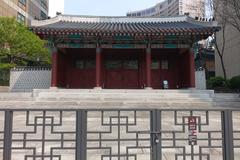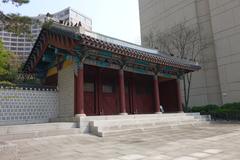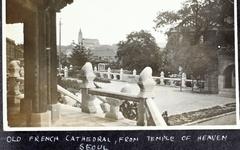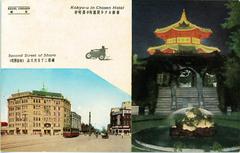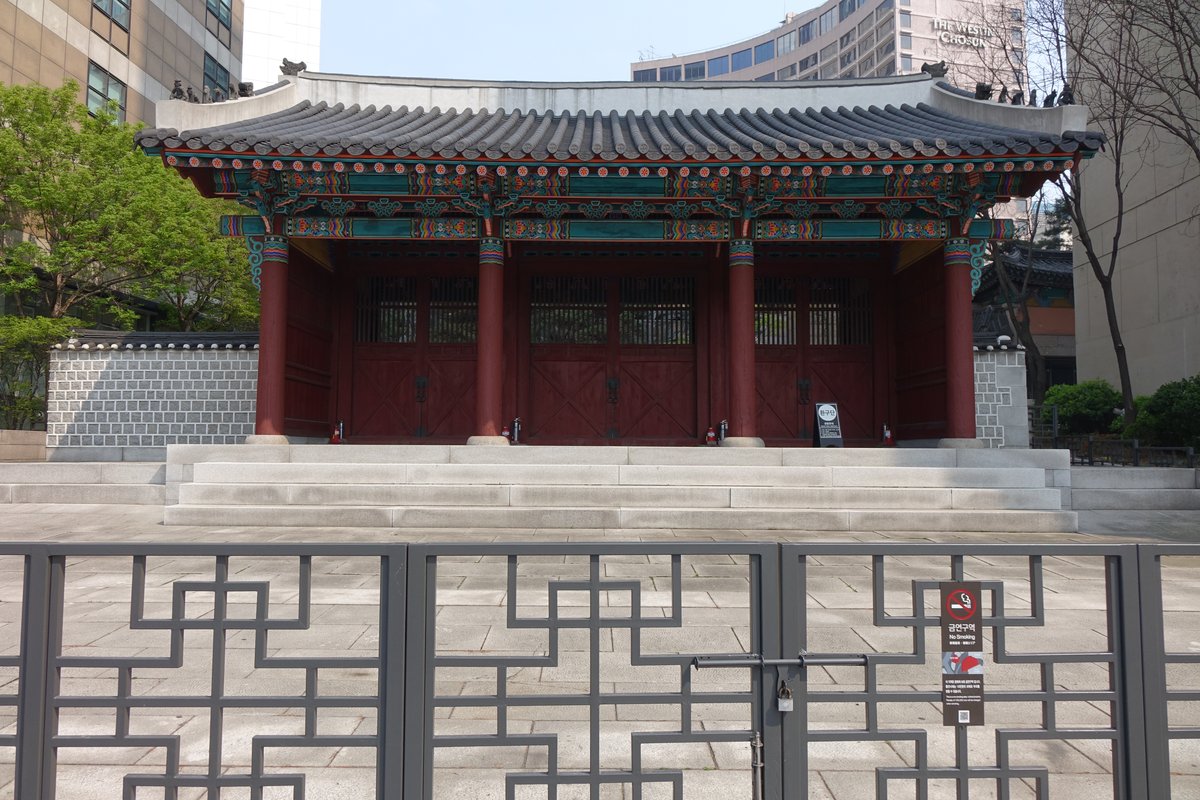
Hwangudan Seoul, South Korea: Visiting Hours, Tickets, and Historical Sites Guide
Date: 15/06/2025
Introduction: The Significance of Hwangudan
Nestled in central Seoul, Hwangudan (환구단, 皇穹壇)—also known as the Altar of Heaven or Wongudan Altar—stands as a testament to Korea’s imperial aspirations during a pivotal period of national transformation. Constructed in 1897 under the order of Emperor Gojong, the first emperor of the Korean Empire, Hwangudan was designed as a ceremonial site for the Rite of Heaven. This Confucian ritual, historically reserved for emperors, marked a symbolic break from tributary relations with Qing China and asserted Korea’s sovereignty and equality among East Asian powers. The architectural inspiration came from Beijing’s Temple of Heaven, with the original layout blending Korean and Chinese motifs. While much of the complex was lost during the Japanese colonial period, key structures such as the Hwanggungu Shrine remain, allowing visitors to engage with this critical chapter of Korean history.
Today, Hwangudan offers a rare window into Korea’s imperial era, situated amid the vibrant cityscape of modern Seoul. This guide provides detailed information on Hwangudan’s history, cultural significance, architectural features, visiting hours, ticketing, accessibility, nearby attractions, and practical tips to help you make the most of your visit. For official information and further details, refer to the Seoul Metropolitan Government and The Seoul Guide.
Contents
- Origins and Construction of Hwangudan
- Imperial Rites and Historical Role
- Architectural Features and Surviving Structures
- Cultural and Political Significance
- Modern Relevance and Preservation
- Visiting Hwangudan: Hours, Tickets, and Accessibility
- Nearby Attractions and Travel Tips
- FAQs
- Visual and Virtual Resources
- Restoration and Contemporary Challenges
- Final Recommendations and Summary
- Recommended Sources
Origins and Construction of Hwangudan
Hwangudan was built in 1897 on the former grounds of Nambyeolgung Palace (Seoul Metropolitan Government). Its construction coincided with the proclamation of the Korean Empire by Emperor Gojong, symbolizing an assertion of Korean sovereignty. The altar’s design emulated the Temple of Heaven in Beijing, a significant reference to the Confucian tradition of imperial rites. The main circular stone altar—representing heaven—was finished in October 1897, and the octagonal Hwanggungu Shrine (황궁우) was completed in 1899. The complex originally included ceremonial gates, auxiliary halls, and a walled enclosure, most of which were demolished during the Japanese colonial era.
Imperial Rites and Historical Role
Hwangudan’s primary function was to host the Rite of Heaven (Jecheonje, 제천제), a ceremonial offering to heaven performed by the emperor to legitimize his rule and pray for the nation’s prosperity. The first and only full-scale Rite of Heaven occurred on October 12, 1897, during Emperor Gojong’s enthronement as emperor (Seoul Metropolitan Government). This act was a powerful declaration of Korea’s independent status. After the annexation of Korea by Japan in 1910, imperial rites ceased, and the site fell into disuse.
Architectural Features and Surviving Structures
Original Complex Design
The Hwangudan complex was designed by Sim Uiseok, a leading royal architect of the era (The Seoul Guide). The original layout included:
- Main Altar: A three-tiered circular stone platform representing heaven.
- Hwanggungu Shrine: An octagonal, three-story structure built in 1899 to house spirit tablets and venerate King Taejo.
- Stone Drums: Three ceremonial drums installed in 1902, commemorating the 40th year of Emperor Gojong’s reign.
- Memorial Tablets Hall: For ancestral worship.
- Three-Arched Stone Gate (Sammun): The main ceremonial entrance (Korea JoongAng Daily).
Surviving Structures
Much of the original site was demolished in 1913 for the construction of the Josun Railway Hotel (now the Westin Chosun Hotel). However, several key remnants endure:
- Hwanggungu Shrine: The octagonal pavilion with yellow roof tiles remains the focal point and is a rare example of late Joseon imperial architecture (Atlas Obscura).
- Stone Drums: Three intricately carved drums symbolize imperial milestones.
- Three-Arched Gate: Removed during hotel construction and returned to its original location in 2007 (Wikipedia).
- Stone Balustrade Fragments: Part of the original altar enclosure.
These elements are now integrated into the hotel grounds but remain accessible to the public from surrounding sidewalks (Visit Seoul).
Cultural and Political Significance
The construction and use of Hwangudan were intertwined with Korea’s efforts to modernize and assert national identity at the turn of the 20th century. By adopting imperial titles and performing the Rite of Heaven, Emperor Gojong proclaimed Korea’s independence from the Qing dynasty’s tributary system and sought to elevate the nation’s international standing. Post-annexation, the site became a symbol of lost sovereignty and suffered extensive destruction, further reflecting the turbulent history of Korea’s transition into the modern era.
Modern Relevance and Preservation
Hwangudan was designated Historic Site No. 157 in 1967 (Wikipedia), and restoration efforts have focused on preserving the remaining structures and enhancing public understanding of their significance. The return of the main gate in 2007 and restoration work on the shrine and drums between 2015 and 2017 underscore ongoing commitment to heritage conservation, despite urban pressures and the loss of much of the original complex (Visit Seoul).
Visiting Hwangudan: Hours, Tickets, and Accessibility
Location & Getting There
- Address: 112 Sogong-ro, Jung-gu, Seoul, South Korea (The Seoul Guide)
- Nearest Subway: City Hall Station (Line 1 or 2, Exit 6 or 7)—about 2 minutes on foot.
Visiting Hours
- Hours: Open daily, 9:00 AM to 6:00 PM. Last admission is typically 30 minutes before closing. Hours may vary during holidays or special events.
- Access: The main shrine and drums are visible from the public areas around the Westin Chosun Hotel. Direct entry to the inner grounds is restricted; there is no enclosed ticketed area (Visit Seoul).
Admission
- Entry: Free of charge; no tickets required.
Accessibility
- Wheelchair Access: The site is mostly accessible via public sidewalks. Some uneven surfaces may exist, but main viewing areas are suitable for wheelchairs and strollers.
- Facilities: Restrooms available at nearby City Hall and Deoksugung Palace.
Nearby Attractions and Travel Tips
Hwangudan is centrally located, making it easy to combine with other major sites:
- Deoksugung Palace: Blend of Korean and Western architecture, Royal Guard ceremony.
- Seoul City Hall & Plaza: Cultural events and public exhibitions.
- Cheonggyecheon Stream: Urban walking path.
- Myeongdong & Namdaemun: Shopping and street food.
- Bukchon Hanok Village & Insadong: Traditional culture and crafts.
Visit in spring or autumn for the best weather. Early mornings or late afternoons are quieter and provide better light for photography.
Frequently Asked Questions (FAQs)
Q: What are the official visiting hours?
A: 9:00 AM to 6:00 PM daily, with last admission 30 minutes before closing.
Q: Is there an entrance fee?
A: No, entry is free.
Q: Can I take guided tours?
A: No regular tours, but some city walking tours include Hwangudan.
Q: Is the site wheelchair accessible?
A: Main viewing areas are accessible; some historic surfaces may be uneven.
Q: Can I use a drone?
A: Drone use requires official authorization.
Q: How do I get there by public transport?
A: City Hall Station (Lines 1 & 2), Exit 6 or 7.
Visual and Virtual Resources
Enhance your visit by exploring:
- High-quality images and virtual tours on the Visit Seoul website.
- Online galleries and maps with alt text such as “Hwangudan altar in Seoul” or “Hwanggungu octagonal shrine.”
- Digital guides and interpretive signage at the site (Atlas Obscura).
Restoration and Contemporary Challenges
Preservation Efforts
Hwangudan’s remains are protected as a designated historic site. Efforts since the 1960s, including restoration of the shrine and return of the main gate, have stabilized the site (Wikipedia). However, the urban development surrounding Hwangudan, especially the Westin Chosun Hotel, limits further restoration.
Urban and Policy Challenges
The juxtaposition of heritage preservation and commercial pressures in central Seoul presents ongoing challenges (The Star). While not as crowded as other sites, Hwangudan’s central location means it sees steady visitor traffic, requiring careful management to balance accessibility with conservation. Funding for additional restoration is often limited due to competing priorities in the tourism and development sectors (Travel and Tour World).
Summary and Final Recommendations
Hwangudan is a unique cultural landmark reflecting Korea’s brief imperial era and ongoing resilience. Despite significant historical loss, the surviving shrine, stone drums, and gate offer visitors a meaningful connection to a pivotal moment in Korean history. Free admission, central location, and proximity to other major sites make Hwangudan an essential stop for history enthusiasts and travelers alike.
Visitor Recommendations:
- Visit during spring or autumn for comfortable weather.
- Combine your visit with nearby Deoksugung Palace, Myeongdong, and Insadong.
- Use official tourism resources for up-to-date information and virtual tours.
For more information, consult the Visit Seoul official website and Seoul Metropolitan Government page.
Reliable Sources and Further Reading
- Exploring Hwangudan: Seoul’s Historic Altar of Heaven – Visiting Hours, Tickets & Travel Tips, Seoul Metropolitan Government (https://english.seoul.go.kr/hwangudan-altar/)
- Visiting Hwangudan Altar in Seoul: Hours, Tickets, History, and Nearby Attractions, The Seoul Guide (https://www.theseoulguide.com/hwangudan-altar-wongudan-altar/)
- Hwangudan Visiting Hours, Tickets, and Guide to Seoul’s Historic Hwangudan Altar, Visit Seoul (https://english.visitseoul.net/attractions/Wongudan%20Altar/ENP004198)
- Hwangudan Seoul: Visiting Hours, Tickets, History, and Travel Tips, Visit Korea (https://english.visitkorea.or.kr/svc/whereToGo/locIntrdn/rgnContentsView.do?vcontsId=81375)
- Hwangudan (Wikipedia) (https://en.wikipedia.org/wiki/Hwangudan)
- The dawn of the Korean empire, Korea JoongAng Daily (https://koreajoongangdaily.joins.com/2009/06/14/features/The-dawn-of-the-Korean-empire/2906119.html)
- Hwangudan, Atlas Obscura (https://www.atlasobscura.com/places/hwangudan-south-korea)
- Visit Seoul – Hwangudan Altar (https://english.visitseoul.net/attractions/Hwangudan-Altar_/4202)
- Seoul Faces Challenges to Become Sustainable City, The Star (https://www.thestar.com.my/business/insight/2024/07/17/seoul-faces-challenges-to-become-sustainable-city)
- South Korea tourism sees setbacks amid growing political tensions but long-term growth still promising for cultural tourism, Travel and Tour World (https://www.travelandtourworld.com/news/article/south-korea-tourism-sees-setbacks-amid-growing-political-tensions-but-long-term-growth-still-promising-for-cultural-tourism-new-travel-updates-you-need-to-know/)
